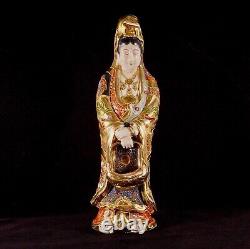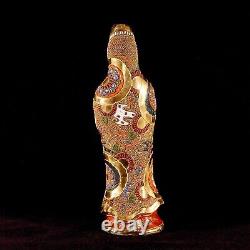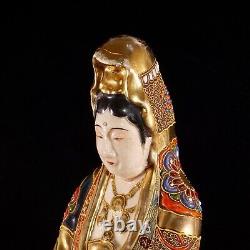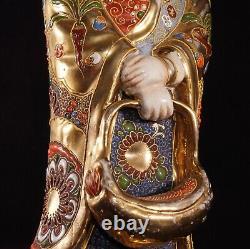Rare antique Japanese satsuma okimono Kannon/ Guan Yin figure with a fish basket








Gorgeous finely moulded and extensively decorated figure of Gyoran Kannon, the goddess of mercy and compassion and the patroness of fishermen. She is depicted with a fish basket in her clasped hands. Her long flowing robes are richly gilt and decorated with raised enamels, lotus pattern representing pureness and berries and vegetables patterns representing abundance and fertility. She looks downwards watching the suffering of the world. The figure is made in the mixed satsuma/kutani style in late 19th - early 20th century.
It is in excellent condition without any chips, cracks or restoration. It stands approximately 30 cm tall. There is some age-related wear to gilding (please see photos). Literally Kannon with Fish Basket. One of 33 Forms of Kannon.
In China, her images begin to appear frequently in 15th-century encyclopedias and scroll paintings. In Japanese artwork, Gyoran is typically depicted holding a fishing basket or standing atop a fish, which symbolize her role as the patron of maritime safety and good fishing.
She is associated with a Tang-era Chinese tale (with many variations) about a young and attractive woman who appears as a fishmonger (carrying a basket full of fresh and shiny fish) to aid a riverside market town beset by a nasty dragon who, each day, makes giant waves to capsize the boats of merchants and shoppers. However, all coins that miss the basket, she says, will be used to build a bridge, so all can cross safely over the raging river. The men, blinded by her beauty and their own sexual desire, tossed their coins poorly -- not one landed in the basket. This Chinese tale, variations of it, and other stories about the Fish Basket goddess portray her, in varying degrees, as a seductress, one who uses the bait of sexuality or promise of marriage to enlighten men. In the end, however, she remains a virgin. Her imagery as seductress is a didactic tool to help people overcome their sexual lust and break free of sexual desire. Says scholar Jeong Eun Kim. The themes of fish and fish basket, however, seem not to be crucial elements in depicting Yulan Guanyin as a seductress. Also, says independent scholar Wayne Woo of Singapore. The great koi fish in her imagery is a symbol of majesty that awes the raksas, nagas, and demons. Into submission, and the basket is where they are contained. In modern Japan, the Fish-Basket story appears to have been stripped of its seductress theme. She asked Kannon to grant her wish for a good husband. The wish was granted and later the girl herself was considered an incarnation of Kannon.In modern Japan, Gyoran Kannon is the protector deity of young men looking for a bride.

